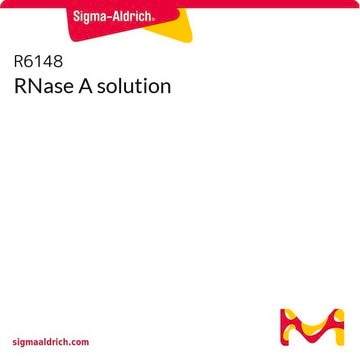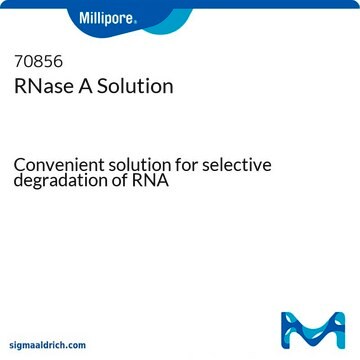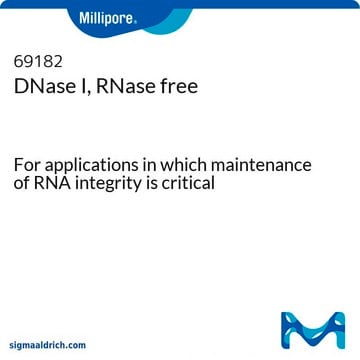11119915001
Roche
RNase, DNase-free
from bovine pancreas
Sinonimo/i:
Rnase
About This Item
Prodotti consigliati
Origine biologica
bovine pancreas
Livello qualitativo
Forma fisica
solution
Attività specifica
≥30 units/mg protein
Confezionamento
pkg of 500 μg (1 ml)
Produttore/marchio commerciale
Roche
tecniche
DNA purification: suitable
Temperatura di conservazione
−20°C
Categorie correlate
Descrizione generale
Applicazioni
Definizione di unità
One unit produces a decrease in absorbance at 260 nm, which is equivalent to a total conversion of RNA to oligonucleotides in one minute at +25 °C.
Stato fisico
Nota sulla preparazione
- For small-scale isolation of plasmid DNA ("miniprep" from a 1.5 ml bacterial culture), use 0.5 μl of RNase, DNase-free in a reaction volume of 50 μl.
- To isolate plasmid DNA from a 100 ml bacterial culture, use 8 μl of RNase, DNase-free in a reaction volume of 2 ml.
- To isolate genomic DNA from cultured mammalian cells (5 x 107 cells), use 8 μl of RNase, DNase-free in a reaction volume of 2 ml.
Working solution: Storage and Dilution Buffer: 10 mM Tris-HCl, 5 mM CaCl2, 50% glycerol (v/v), pH 7.0.
Altre note
Codice della classe di stoccaggio
12 - Non Combustible Liquids
Classe di pericolosità dell'acqua (WGK)
WGK 1
Punto d’infiammabilità (°F)
No data available
Punto d’infiammabilità (°C)
No data available
Certificati d'analisi (COA)
Cerca il Certificati d'analisi (COA) digitando il numero di lotto/batch corrispondente. I numeri di lotto o di batch sono stampati sull'etichetta dei prodotti dopo la parola ‘Lotto’ o ‘Batch’.
Possiedi già questo prodotto?
I documenti relativi ai prodotti acquistati recentemente sono disponibili nell’Archivio dei documenti.
I clienti hanno visto anche
Protocolli
0.1 mU RNase, DNase-free degrades 1 μg RNA in 30 min at + 37 °C in a reaction volume of 50 μL PCR grade water. The protein concentration of RNase, DNase-free is 0.5 μg/μL.
Il team dei nostri ricercatori vanta grande esperienza in tutte le aree della ricerca quali Life Science, scienza dei materiali, sintesi chimica, cromatografia, discipline analitiche, ecc..
Contatta l'Assistenza Tecnica.













